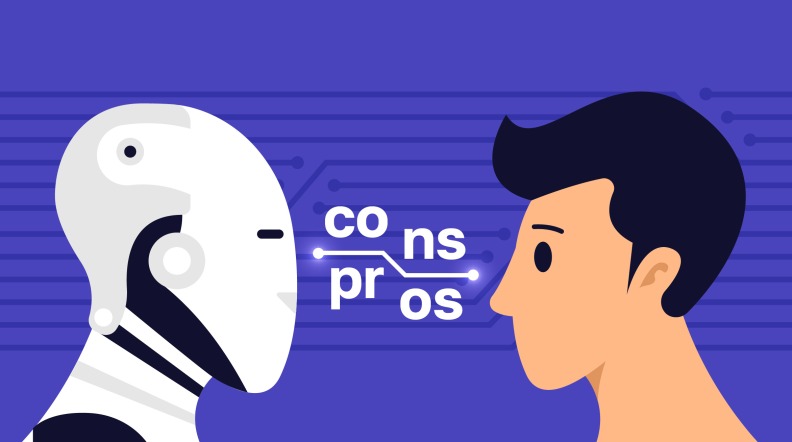Pros and Cons of AI: A Comprehensive Exploration






Artificial Intelligence, or AI, is reshaping the way we live, work, and interact. Its rapid advancement presents a mix of opportunities and challenges that affect various aspects of human life. From AI-powered robots assisting in surgeries to complex algorithms improving the efficiency of industries, the impact of AI is undeniably profound. Yet, as we integrate AI more deeply into our lives, concerns about job displacement, ethical dilemmas, and overreliance on technology emerge, prompting a careful consideration of its implications.
Understanding the pros and cons of AI is essential for leveraging its benefits while mitigating its drawbacks. By examining how AI enhances human capabilities through error-free processing and automating mundane tasks, alongside the risks it poses, such as the potential for job loss and ethical quandaries, we can navigate its integration into society more thoughtfully. This exploration aims to provide a balanced view, highlighting how AI’s advancements can be harnessed responsibly for the betterment of humanity.
Introduction to AI: Understanding Its Role in Today’s World
Artificial Intelligence has become a cornerstone of modern innovation, transforming industries and everyday life. Its role extends beyond mere technology, influencing how decisions are made and operations are conducted across global sectors.
What Is Artificial Intelligence?
At its core, Artificial Intelligence is a branch of computer science dedicated to creating systems that can perform tasks requiring human intelligence. This includes learning, reasoning, and self-correction.
The Basics and Beyond
Artificial Intelligence encompasses a wide range of AI programs designed to simulate human thought processes and behaviors. These programs can analyze data, recognize patterns, and make decisions with minimal human intervention. The branch of computer science that deals with AI aims not only to understand intelligence but to build systems that replicate or exceed human capabilities in specific tasks.
Why Do We Use Artificial Intelligence?
AI programs are employed to enhance efficiency and innovation. By automating routine tasks, they free up human resources for more complex activities, driving progress in various fields.
From Efficiency to Innovation
The use of AI extends from automating simple tasks to pioneering groundbreaking innovations. AI programs contribute to significant advancements in sectors like healthcare, where they assist in diagnosing diseases, and in environmental science, through climate modeling and conservation efforts. The goal is to utilize AI not just for operational efficiency but also as a catalyst for innovation.
Pros of Artificial Intelligence: Enhancing Human Capabilities
AI technology is at the forefront of enhancing human capabilities, offering solutions that improve productivity, safety, and decision-making.
1. Error-Free Processing and Reduced Human Error
The precision of AI minimizes mistakes, especially in tasks where the cost of human error can be high. Human beings, with their inherent potential for error, can benefit from AI’s consistency in handling repetitive tasks.
The Quest for Perfection
AI’s ability to process information without fatigue or bias contributes to a higher standard of accuracy in various applications. From financial forecasting to medical diagnoses, AI helps in achieving near-perfection, reducing the risk of human error and enhancing the reliability of outcomes.
2. Continuous Work: The 24/7 Availability Advantage
Unlike humans, AI programs and AI-powered chatbots can operate round-the-clock, offering accurate results without the need for breaks or sleep. This continuous availability significantly boosts productivity and service levels.
Never Needing a Break
AI’s non-stop operational capacity is particularly beneficial in customer service and online support roles, where AI-powered chatbots provide immediate responses at any hour. This 24/7 availability ensures that businesses can offer consistent service, enhancing customer satisfaction and operational efficiency.
3. Automating Repetitive Tasks: From Mundane to Automated
AI excels at automating repetitive tasks such as responding to emails and analyzing data, allowing humans to focus on more strategic activities.
The Liberation from Monotony
The automation of mundane tasks not only increases efficiency but also reduces the monotony of the workplace. Employees are freed from repetitive work, enabling them to engage in more creative and fulfilling activities. This shift can lead to higher job satisfaction and innovation.
4. Risk Mitigation: Implementing AI in Hazardous Situations
Creating an AI system capable of operating in dangerous environments can significantly reduce risks to human safety.
Safer Solutions
AI technologies are increasingly deployed in situations where human safety is at risk, such as in disaster response, hazardous material handling, and deep-sea or space exploration. By taking on these high-risk tasks, AI not only protects human lives but also opens new frontiers in research and development.
5. Informed Decision-Making: AI-Powered Insights and Digital Assistance
Artificial Intelligence (AI) has revolutionized the way decisions are made, with digital assistants and applications of AI providing unprecedented access to data and insights. For instance, Google Maps uses AI to analyze traffic data in real-time, offering the best routes and reducing travel time. This capability of AI to process vast amounts of data quickly and accurately enables more informed decision-making across various sectors, enhancing efficiency and productivity.
Smarter Choices
By harnessing the power of AI, individuals and businesses can make smarter choices. Digital assistants, equipped with the ability to learn from user interactions, offer personalized recommendations and support, thereby enhancing user experience. Furthermore, AI applications in data analysis help in identifying patterns and predicting outcomes, which is crucial for strategic planning and risk management. This level of insight and assistance was unimaginable a few decades ago, highlighting how AI contributes to more intelligent decision-making processes.
6. Cost Reduction: How AI is Making Operations More Affordable
AI is a game-changer when it comes to reducing operational costs. By automating routine tasks, companies can save on labor costs and increase efficiency. AI systems are also capable of optimizing resource allocation and energy consumption, leading to significant savings. Furthermore, the predictive capabilities of AI can help in maintenance planning, reducing downtime and associated costs. These factors combined make AI a powerful tool for cost reduction.
Financial Implications
The financial benefits of implementing AI extend beyond mere cost savings. AI-driven analytics can uncover new revenue opportunities and optimize pricing strategies, contributing to increased profitability. Moreover, the efficiency gains from automating processes can free up resources for investment in innovation and growth initiatives. However, it’s important for businesses to consider the upfront investment in AI technology and balance it against the long-term savings and revenue potential.
7. New Inventions and Innovations Through AI
AI is at the forefront of driving new inventions and innovations, solving complex problems that were once thought insurmountable. For instance, generative AI has opened new avenues in creative industries, while AI applications in healthcare are making personalized medicine a reality. These advancements are pushing the boundaries of what’s possible, offering solutions that improve lives and transform industries.
Pushing Boundaries
The ability of AI to process and analyze large volumes of personal data raises concerns regarding privacy and unauthorized access. However, it also provides a unique opportunity to address ethical dilemmas and complex problems in innovative ways. For example, AI can help in identifying ethical issues in digital marketing by analyzing patterns that may indicate conscious or unconscious bias. Despite the drawbacks of AI, such as potential ethical dilemmas and privacy issues, its capacity to drive new inventions and tackle complex challenges is undeniable.
Cons of Artificial Intelligence: The Flip Side of Progress
The advancement of AI technology offers a plethora of benefits, yet it also presents challenges and drawbacks. From ethical concerns to the impact on human workers, understanding the advantages and disadvantages of artificial intelligence is crucial for navigating its implications on society.
1. High Implementation Costs: The Price of Advanced Technology
Implementing AI systems involves high initial costs, including the expense of acquiring the technology, integrating it into existing systems, and training staff. This financial barrier can limit access to AI benefits for smaller businesses and organizations.
Weighing the Costs
While the long-term benefits of AI, such as increased efficiency and cost savings, are significant, the upfront investment required can be a major obstacle. Businesses must carefully consider the return on investment, taking into account not only the financial cost but also the time and resources needed to effectively implement and utilize AI technologies.
2. Job Displacement: The Rising Concern Over Unemployment
The automation of tasks through AI poses a risk to jobs, especially those involving repetitive or dangerous tasks. This has led to concerns about widespread unemployment and the need for workforce retraining.
Human Workforce Impact
As AI continues to evolve, the displacement of jobs by machines is a growing concern. However, it also opens up opportunities for human workers to engage in more creative and complex tasks, provided there is a commitment to retraining and education. Balancing the implementation of AI with measures to support the workforce is essential for mitigating the negative impact on employment.
3. Creativity at Stake: Can AI Truly Innovate?
Despite its capabilities, AI lacks the innate creativity and emotional depth that humans possess, raising questions about its ability to truly innovate.
The Debate on Originality
While AI can generate novel ideas or designs, the debate continues on whether its outputs can be considered truly original or creative. AI’s ability to innovate is based on data and algorithms, lacking the emotional and experiential context that often drives human creativity. This distinction highlights the complementary roles that AI and humans can play in the creative process.
4. Ethical and Emotional Disconnect: The AI Dilemma
The use of AI, especially in areas like digital marketing, raises ethical questions related to privacy, consent, and the potential for bias. The lack of emotional understanding in AI systems can also lead to decisions that neglect human values and ethical principles.
Navigating the Moral Maze
Addressing the ethical and emotional disconnect in AI involves ongoing dialogue, regulation, and the development of AI systems that prioritize ethical principles. By incorporating human oversight and intervention, it is possible to guide AI towards outcomes that respect human dignity and values, ensuring that AI serves as a tool for positive impact rather than a source of ethical dilemmas.
5. Dependence on Technology: When AI Takes Over
As we utilize AI more in our everyday lives, a significant drawback of AI emerges: the risk of becoming too dependent on technology. This dependence raises concerns about our ability to function without AI assistance. For example, when AI handles tasks such as managing personal data, there’s the risk of unauthorized access, leading to ethical dilemmas. Moreover, as generative AI advances, the line between human creativity and machine output becomes blurred, further deepening our reliance on technology.
The Risk of Overreliance
Implementing AI to complete tasks, especially dangerous tasks, showcases the technology’s ability to protect human lives and improve efficiency. However, the overreliance on AI to complete tasks can lead to potential drawbacks. For instance, should an AI system fail or get compromised, the consequences could be severe, highlighting the importance of maintaining a balance between using AI and retaining human oversight in critical operations.
AI in Various Sectors: A Closer Look at the Impact
The advantages and disadvantages of AI span across various sectors, each experiencing unique impacts. AI can automate routine tasks, provide access to personal data for more informed decisions, and drive innovations like autonomous vehicles. However, this comes with the disadvantage of AI potentially overshadowing the human touch in services and decision-making. Machine learning algorithms analyze real-time data to improve efficiency but may also lead to a loss of personal connection and understanding in sectors like healthcare and education.
Advantages and Disadvantages of AI in Healthcare, Education, and More
In healthcare, education, and many other fields, the advantages and disadvantages of AI are evident. AI can automate administrative tasks, allowing professionals to focus on more critical aspects of their work. However, reliance on AI for access to personal information and decision-making could lead to a decrease in human interaction, which is vital in these sectors.
Sector-Specific Insights
Looking closely at different sectors, the impact of AI varies. In healthcare, AI enables faster diagnosis and personalized treatment plans but raises questions about patient privacy and the role of doctors. In education, AI facilitates personalized learning experiences but could diminish the value of teacher-student interactions. Each sector must navigate the balance between leveraging AI for its benefits while mitigating its disadvantages.
Implementing AI: Strategies for Success
Successfully implementing AI into business operations or personal use requires a strategic approach that considers both the potential of AI and ML technologies and their limitations. The key is to identify areas where AI can significantly enhance efficiency and effectiveness without completely replacing the human elements that are crucial for creativity and ethical decision-making.
Choosing the Right AI Program: A Guide for Businesses and Individuals
Selecting the appropriate AI and ML programs is crucial for achieving the desired outcomes. This choice depends on the specific needs and goals of the business or individual, emphasizing the importance of understanding the capabilities and limitations of different AI technologies.
The Path to AI Integration
Integrating AI into operations involves a step-by-step process that begins with identifying the tasks that AI can improve. Following this, it’s essential to choose the right AI programs, train staff to work alongside AI, and continuously evaluate the impact and adjust strategies as needed. This approach ensures a smooth transition to AI-enhanced operations while maintaining a balance between automation and human oversight.
The Future of AI: Predictions and Possibilities
The future of AI holds exciting predictions and possibilities, from advancements in machine learning algorithms to more sophisticated human-AI interactions. As technology evolves, we can expect AI to become more integrated into our daily lives, transforming industries and creating new opportunities for innovation and efficiency.
What Lies Ahead: Forecasting AI’s Evolution
Forecasting the future of AI suggests a trajectory towards more autonomous systems, enhanced decision-making capabilities, and innovations that we have yet to imagine. The evolution of AI technology promises to reshape the way we live, work, and interact with the world around us.
The Next Frontier
The next frontier in AI development includes exploring the ethical implications of autonomous systems, enhancing AI’s ability to understand human emotions, and creating more personalized AI-driven experiences. As we venture into this uncharted territory, the potential of AI to positively impact society is boundless, provided we navigate its challenges wisely.
FAQs: Answering Your Questions About AI
Understanding AI involves addressing common questions about its capabilities and impact. From reducing operational costs to its role in creative processes, AI’s influence spans a wide range of applications, raising important discussions about its integration into various aspects of life and work.
How Can AI Reduce Operational Costs?
AI reduces operational costs by automating routine tasks, optimizing resource allocation, and improving process efficiency. These savings can then be redirected towards strategic initiatives, innovation, and enhancing customer experiences, demonstrating AI’s role in driving cost-effective business operations.
Can AI Replace Human Creativity and Intelligence?
While AI can enhance certain aspects of creativity and intelligence, it lacks the human touch that is essential for truly innovative thinking and emotional understanding. Relying on AI for tasks requiring deep creativity and emotional intelligence may not yield the desired outcomes, highlighting the irreplaceable value of human insight and ingenuity.
What Are the Everyday Applications of AI?
AI’s everyday applications include virtual assistants that understand voice commands, enhancing customer experiences through personalized recommendations, and automating mundane tasks. These applications showcase AI’s role in making daily life more convenient and efficient, though they also emphasize the importance of balancing technology use with human interaction.
Conclusion: Balancing the Scale of AI Advantages and Disadvantages
The journey through the pros and cons of artificial intelligence reveals a landscape filled with promise and caution. AI can automate internal processes and handle automating repetitive tasks, presenting significant benefits of AI, such as increased efficiency and freeing humans from monotonous work. However, the potential disadvantages, like the lack of creativity and potential misuse, remind us of the careful consideration needed when adopting AI. It challenges us to nurture our critical thinking skills, ensuring that as we adopt AI, we do so with a balanced perspective that appreciates both its potential and its limitations.
Navigating the AI Landscape: Making Informed Decisions in the Age of Automation
In an era where AI tools transform everything from self-driving cars to assembly lines, understanding the nuances of AI becomes crucial. Training data, data scientists, and complex data play pivotal roles in crafting AI solutions that range from simple tasks to making accurate predictions and enhancing computer vision. Examples of AI, such as AI in business and freeing up human resources for more creative endeavors, illustrate the positive impacts of AI adoption. Yet, awareness of the negative effects, driven by inadequate sets of data or misinterpretations, is essential. Companies use AI to navigate vast amounts of data generated daily, showcasing the transformative power of AI when leveraged with mindfulness towards its complex nature.